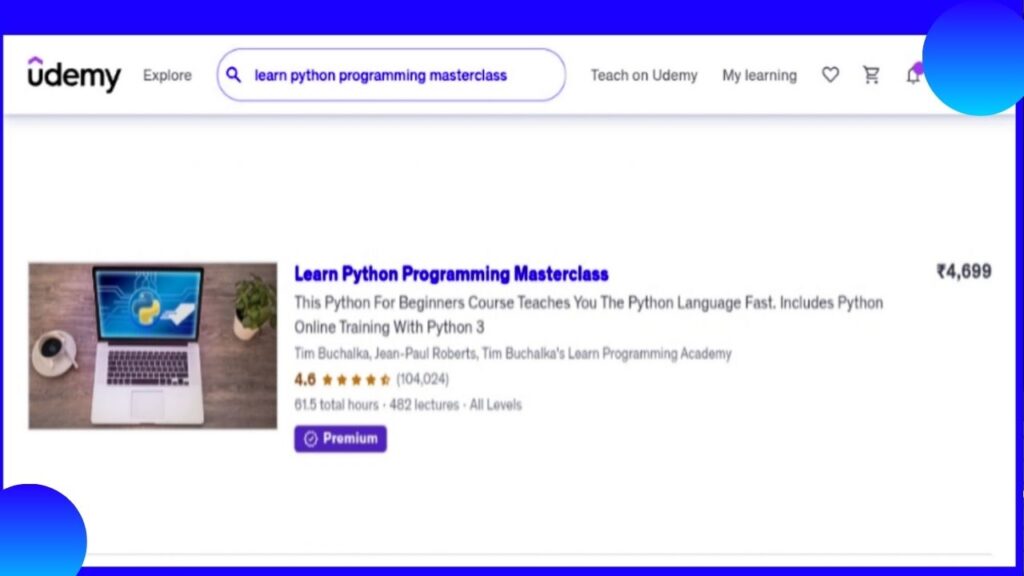Creating an online course is a significant achievement, but simply publishing it on Udemy doesn’t guarantee success. With thousands of courses available, standing out requires a strategic Udemy course marketing approach.
Leveraging Udemy’s algorithm, SEO optimization, social media, and other promotional tactics, you can drive more traffic to your course and increase enrollments.
This blog post will cover the most effective strategies for Udemy course marketing in 2025, helping you attract more students and generate higher revenue.
Table of Contents
Optimizing Your Course for Udemy SEO
How to Rank Higher in Search Results
Udemy’s search algorithm prioritizes courses based on relevance, engagement, student reviews, and course freshness.
To improve your course’s visibility, regularly update your content, use relevant keywords in your course title and description, and encourage student interaction through Q&A and discussions.
➡️ You should use keywords in your Course title
Your course title is the first element that students and Udemy’s algorithm notice. A clear, optimized title helps potential students understand your course. It also plays a crucial role in SEO, as Udemy prioritizes titles with relevant search terms.

For example, instead of a generic topic like “Mastering Coding”, consider a more specific and keyword-focused topic like “Learn Python Programming for Beginners/masterclass”. This not only tells students exactly what they will learn, but it also targets the popular search term “Python Programming.”
The goal is to make your title clear and descriptive, focusing on the primary keywords your target audience is likely to search for. A strong title will make it easier for students to find your course when searching for related topics.
➡️ Incorporating Keywords into Your Subtitle
The subheading is the perfect place to add more details about your course and reinforce your main keywords. It provides more context about what the course offers and what students will gain by enrolling.
Use this place as an opportunity to add additional high-traffic keywords that complement your title and make your course more discoverable.
For example, if your title is “Python Programming for Beginners,” you could use a subheading like “Learn Python with Hands-on Projects and Real-World Examples.” Pay close attention here.
This subheading not only highlights the practical nature of the course but also includes other keywords that potential students might search for, such as “live projects” and “real-world examples.”
A well-crafted subheading helps set your course apart from others and adds depth to your keywords, making your course more likely to show up in a variety of relevant searches.
➡️ Optimizing Your Course Description with Keywords
The course description is where you can fully explain the value of your course and why students should enroll. However, while it’s crucial to include relevant keywords in your description, it’s important to do so naturally. “Keyword stuffing“, “repeating keywords too often” – can make your description sound unnatural, and this will negatively impact your subject’s ranking.
Instead, focus on providing detailed, valuable information about what students will learn. Weave your keywords into the description in a way that flows naturally. For instance, instead of overloading the text with the same keyword, vary your terminology.
If your course is about Python programming, you can mention “Python basics,” “Python for coding,” “learning Python,” and “programming in Python” throughout your description. This will help you target a wider range of search terms while maintaining readability.
By using keywords naturally and providing a clear, informative course description, you ensure that your content resonates with students and the search algorithm alike.
➡️ Here’s how you can Find High-Traffic Keywords
To choose the right keywords, you can use Google Keyword Planner, UberSuggest, or Udemy’s search bar to see what terms are popular in your subject area. These tools can help you find high-traffic keywords that people are actively searching for.

Additionally, you can look at popular courses in your category and analyze the keywords they use in their titles, subtitles, and descriptions.
By identifying the most relevant and frequently searched terms for your topic, you can ensure that your course is using the best keywords to attract students who are looking for exactly what you have to offer.
➡️ Regular updates are very important
Once your course is published, it’s important to keep it fresh and relevant. Updating your course content, including revising your title, subtitle, or description as trends shift, can improve its SEO.
Udemy’s search algorithm prefers regularly updated content because it ensures that the course is active and provides current, useful information.
Periodically revisiting your course keywords and making changes based on new trends or student feedback will help you maintain high visibility in search results.
Keep your course content up-to-date with new materials or updates to the information you teach so you can maintain your relevance.
By mastering Udemy course marketing techniques like SEO, you increase your course’s chances of ranking higher in Udemy search results.
Leveraging Social Media & Content Marketing
Creating Valuable Content to Attract Students
Social media is a powerful tool to promote your course. Providing valuable content related to your course topic can attract potential students. Here’s what you can do:
- Write blog posts related to your course topic and link to your Udemy course.
- Create short-form videos on TikTok, Instagram, or YouTube highlighting key concepts.
- Host live webinars or Q&A sessions to engage your audience.
Best Platforms for Promoting Online Courses
Different social media platforms offer various ways to promote your Udemy course:
- YouTube: Share course previews, tutorials, and student testimonials.
- LinkedIn: Post educational content and interact with industry professionals.
- Facebook Groups: Engage with communities interested in your niche.
- Reddit & Quora: Answer relevant questions and subtly mention your course when appropriate.
An effective Udemy course marketing strategy involves consistently sharing valuable content to attract and convert potential students.
Using Email Marketing to Build an Audience
How to Create a Lead Magnet for Your Course
Building an email list is a fundamental strategy for long-term course success. A lead magnet serves as an incentive to encourage potential students to share their email addresses, allowing for direct engagement and promotional opportunities. It should be a high-value, relevant resource that aligns with the course content. Examples:
- Free eBooks or PDF guides
- Mini video lessons
- Exclusive cheat sheets
- Webinars or live sessions
Once you have an email list, you can nurture leads with valuable content and occasional course promotions.
Nurturing Leads into Paying Students
Udemy course marketing is crucial for attracting students and maximizing course sales. Successful instructors don’t just rely on Udemy’s marketplace; they actively optimize their courses using SEO, social media, and email marketing.
A strong marketing strategy includes leveraging student reviews, running paid ads, and collaborating with influencers. By applying proven promotional tactics, course creators can expand their reach, improve visibility, and generate consistent revenue.
Understanding Udemy’s algorithm and using the right tools can turn an online course into a profitable long-term asset. Here’s how you can turn subscribers into students:
- Send educational emails related to your course topic.
- Share success stories from previous students.
- Offer time-limited discounts to create urgency.
- Personalize emails based on student needs and interests.
A well planned email strategy can significantly boost Udemy course marketing efforts and drive consistent enrollments.
Paid Advertising Strategies for Course Sales
When and How to Use Facebook Ads, Google Ads, or Udemy Ads
Paid advertising is often described as an “excellent way” to increase course visibility because it offers some unique advantages over other methods, though it doesn’t mean that other strategies aren’t valuable. One key benefit of paid advertising is its ability to generate immediate exposure.
While organic methods like SEO, social media marketing, and word-of-mouth recommendations can take time to build traction, paid ads can quickly place your course in front of a targeted audience. This is particularly helpful when you’re trying to boost initial enrollments or generate momentum shortly after launching your course
Another advantage is the level of control you get with paid advertising. You can tailor your ads to reach specific demographics, interests, or geographic regions, ensuring that your marketing budget is directed toward the people most likely to enroll in your course. This precision can lead to a higher conversion rate compared to more general, broad-based organic marketing efforts.
However, it’s important to note that while paid advertising can provide a quick and measurable boost in visibility, it often works best when combined with other long-term strategies
- Facebook Ads: Target specific audiences interested in your niche.
- Google Ads: Use search ads to attract people actively looking for similar courses.
- Udemy Ads: Udemy offers paid promotions where they advertise your course in exchange for a revenue share.
To maximize ROI, test different ad creatives, analyze performance, and optimize campaigns based on data insights.
Leveraging Student Reviews & Testimonials
Encouraging Positive Reviews to Boost Credibility
Student reviews play a vital role in Udemy course marketing. Courses with high ratings are more likely to rank higher in search results and attract more students. Here’s how to encourage positive reviews:
- Ask students for feedback after they complete the course.
- Engage with students by answering questions and providing support.
- Provide valuable content that exceeds expectations to earn organic positive reviews.
A course with positive testimonials and high ratings builds credibility and encourages more students to enroll.
Collaborating with Influencers & Affiliates
How Partnerships Can Drive More Sales
Influencer marketing and affiliate programs can significantly boost Udemy course marketing efforts. Here’s how:
- Partner with bloggers and YouTubers in your niche to promote your course.
- Offer affiliate commissions to those who refer students.
- Collaborate with industry experts for guest lectures and cross-promotions.
A strong network of affiliates and influencers can amplify your reach and drive more enrollments.
Marketing your Udemy course effectively requires a mix of SEO, social media engagement, email marketing, paid ads, and partnerships. By implementing these strategies, you can maximize your reach and grow your student base in 2025.





Pingback: 4 Best Udemy Digital Marketing Course
Pingback: How a Udemy Digital Marketing Course Can Boost Your Career in 2025
Pingback: Thinking About Learning Digital Marketing with Udemy?
Pingback: The Pros and Cons of an Online Learning Platform: Is It Right for You?